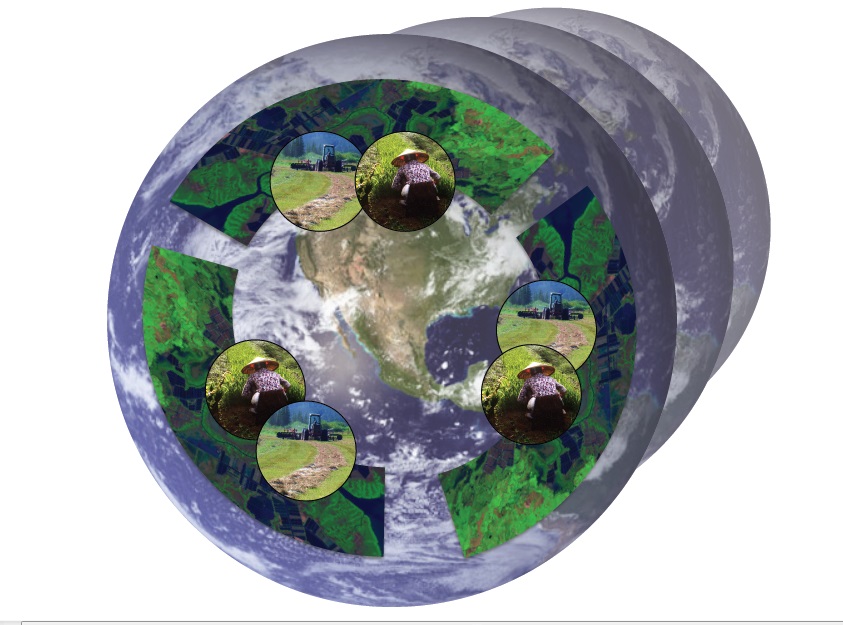Connecting the global to the local – agricultural landscapes from field to orbit
More Agro-ecology at ESA’s 2013 Annual Meeting in Minneapolis
by Liza Lester, ESA communications officer

Collage assembled by Kate Brauman. Image Credits – Globe: Reto Stöckli, Robert Simmon, MODIS teams, NASA. Satellite images: shrimp aquaculture in Honduras, Landsat 7, 1999, Jesse Allen, NASA Earth Observatory. Small photos: Kate Brauman.
Big changes in agriculture are visible on the global scale – changes in crop yields, dietary choices, water use, fertilizer application, soil retention, and nutrient pollution. In some parts of the world, yield lags, revealing opportunities to get more out of land already in production. In others, crop production has sagged or plateaued. Will yields keep increasing as they have in the past? It’s hard to see trajectories without local context, said session organizer Kate Brauman of the University of Minnesota’s Institute on the Environment. Site-specific field work fills in details.
“Agronomy has been working very successfully for a long time, and it’s been focused on practitioners,” said Brauman. “And global analysis can be hard for someone in the field to interpret. How can we take insights from the local to the global scale and make them useful?”
Ecology has great scientists studying the very local, applied art and science of getting more yield out of our crops and the local ecological effects of agriculture, and great scientists studying global trends, said Bauman. It does not have much of a history of cross-pollination between the groups. This session aims to bridge gulfs of scientific culture and of scale, connecting the satellite’s eye view of global change to the view from the field; computational modeling to on-the-ground experimentation; and snapshot observations to daily, seasonal, annual, and decadal change.
 Symposium 20: Integrating Agro-Ecological Research Across Spatial and Temporal Scales
Symposium 20: Integrating Agro-Ecological Research Across Spatial and Temporal Scales
Thursday, August 8, 2013: 1:30 PM-5:00 PM
Organizer: Kate Brauman
More>>>
- PS-29: Agriculture Tuesday, August 6, 2013: 4:30 PM-6:30 PM, Exhibit Hall B
(Poster session) - COS 1: Agriculture I Monday, August 5, 2013: 1:30 PM-5:00 PM, room L100I
(Contributed Oral Session) Grasslands, coffee, excess nitrogen fertilizer - COS 18: Agriculture II Tuesday, August 6, 2013: 8:00 AM-11:30 AM, room 101C
Biodiversity, weeds, spatial organization - COS 80: Soil Ecology Wednesday, August 7, 2013: 1:30 PM-5:00 PM, room M100GD
Includes soybean symbiosis, prairie grazing gradients, and bioenergy constraints. - COS 77: Land-Use And Land-Use History Wednesday, August 7, 2013: 1:30 PM-5:00 PM, room L100H
Consequences of armed conflict, restoration ecology, and shifting away from beef(?). - OOS 24: Managing Belowground Processes In Agroecosystems Thursday, August 8, 2013: 8:00 AM-11:30 AM, room 101B
(Organized Oral Session) The invisible world of roots, fungi, insects, arthropods, microbes, and decomposing plants matter matter very much to crop success and environmental health. This session will evaluate the state of the science and “alternative” agro-ecological systems, and discuss management opportunities. - COS 126: Pollination Friday, August 9, 2013: 8:00 AM-11:30 AM, room L100G
Cranberries, blueberries, and parasitoid wasps.